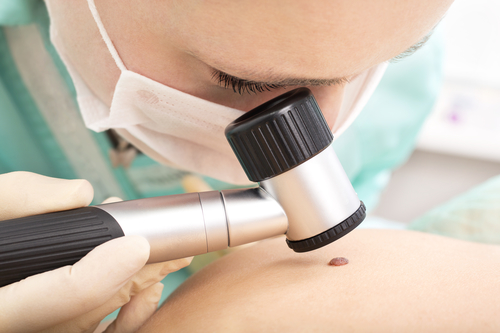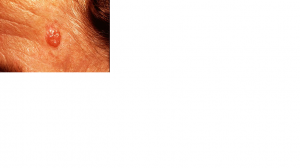 Summer is over, and the amount of time we are spending outside is dwindling. As the tans fade, many will turn to tanning beds to contain the sun-kissed glow to the skin. Everyone knows that tanning beds are bad for you, but just a few times won’t hurt, right? Wrong. Just one use of the tanning bed dramatically increases your chances of developing a form of skin cancer. When detected early, skin cancer is highly treatable, but if left unnoticed, there can be seriously, lasting and reoccurring problems. Here is a breakdown of the different types of skin cancer, how to tell the difference and when to know it’s time to see a dermatologist.
Summer is over, and the amount of time we are spending outside is dwindling. As the tans fade, many will turn to tanning beds to contain the sun-kissed glow to the skin. Everyone knows that tanning beds are bad for you, but just a few times won’t hurt, right? Wrong. Just one use of the tanning bed dramatically increases your chances of developing a form of skin cancer. When detected early, skin cancer is highly treatable, but if left unnoticed, there can be seriously, lasting and reoccurring problems. Here is a breakdown of the different types of skin cancer, how to tell the difference and when to know it’s time to see a dermatologist.
Skin Cancer 101
Skin cancer is defined as an abnormal growth of skin cells in a concentrated area. UV ray exposure or sun damage are the leading causes associated with skin cancer. It affects all skin types, although those with a fair complexion or are susceptible to sunburns are at a higher risk. Although people who are over 40 are more likely to get it, using a tanning bed early on can increase the chances by up to 59 percent. Depending on the type of skin cancer, treatments range from topical medications to chemotherapy and radiation.
Actinic Keratoses
Referred to as AKs, actinic keratoses are precancerous growths on the surface of the skin. They form when the skin is damaged by UV rays and appear as dry, scaly patches or spots. People who form an AK once are susceptible to them reoccurring frequently throughout life. The patches can go away, then reappear once the skin is exposed to the sun.
Although AKs are precancerous, it’s important to visit a dermatologist immediately for treatment before the possibility of squamous cell carcinoma arises. Actinic keratoses are only characterized by physical symptoms. People with these spots might notice a rough patch that is not entirely visible and painful when rubbed. The spot might itch and burn, and the lips on the face may become dry.
Basal Cell Carcinoma
Basal cell carcinoma is the most common form of skin cancer and most diagnosed form in the United States. It appears in common sun-exposed places of the skin like the face, neck and hands. Like all skin cancers, the usage of tanning beds dramatically increases the chances of developing BCC by 40 percent. BCC grows slowly, rarely spreads and is highly treatable, but it’s important to get a worrisome spot checked out immediately when noticed. This form of cancer can destroy bone, tissue and the skin.
Basal cell carcinoma shows up on the skin in various forms. Most commonly, it will appear as a dome-shaped growth with visible blood vessels. It can look as a pink or red patch of scaly skin, like eczema. In addition, it may form as a yellowish-pale scar that won’t heal. The growth will often bleed, ooze then scab over.
Squamous Cell Carcinoma
There are over 700,000 cases of squamous cell carcinoma diagnosed in the United States every year. This form of skin cancer starts off as actinic keratoses, precancerous growths. People who are diagnosed with SCC have had sun exposure to their skin for an extended amount of years. Squamous cell carcinoma is a slow-growing form of skin cancer.
SCC is physically characterized by a rough bump or lump on the skin. It will grow to be dome-shaped, then crust over and bleed. It looks to be a sore that doesn’t heal, and if it does, it will reappear. Squamous cell carcinoma is diagnosed by a dermatologist who will perform a biopsy. Treatments can include excision, surgery, radiation or light therapy. The type of treatment depends on how deep the cancer has grown and how much it has spread.
Melanoma
Melanoma is the deadliest form of skin cancer and is the easiest spread. When detected early enough, it is highly treatable, but it is important to know the waning signs of what to look for. People who spend lots of time in the sun should perform regular body checks for any abnormal moles or growths. You can detect a worrisome spot by looking for the symmetry, border, color, diameter and evolution of the area.
Melanoma can change an pre-existing mole or form a completely new spot on the skin. It can also appear as a dark streak under a finger or toe nail. Melanoma can become deadly if it spreads to the lymph nodes or any internal organs. Depending on the stage it is caught, melanoma is treated by surgery, radiation or even chemotherapy. If you have a concerning spot on your skin, make an appointment with a dermatologist immediately.
The medical professionals at Knoxville Dermatology Group are experienced in catching, diagnosing and treating all forms of skin cancer. To make an appointment, contact us online here, or at (865) 690-9467 today.


